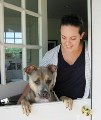
May 2014 by Julie Levy, DVM, PhD, DACVIM, Caitlin Quinn
Audience: Executive Leadership, Foster Caregivers, Public, Shelter/Rescue Staff & Volunteers, Veterinary Team
Video Length: 67 minutes
Innovations in the way we consider marketing adoptions in shelters mean that everyone has the opportunity to put on their PR hat - including medical team members! Once breed-neutral policies are in place, learn how to implement strategies that decrease barriers to adoption and increase live outcomes. Dr. Julie Levy and Caitlin Quinn discuss how to capitalize on existing programs and materials to promote adoptions and ultimately boost the visibility of your shelter in the community in this presentation given at the University of Florida's 7th Annual Maddie's® Shelter Medicine Conference.
Learning Objectives:
- Learn to remove barriers to adoption through innovative marketing techniques, specifically designed for easy implementation in the shelter environment
- Understand how programs designed for enrichment and increased quality of life can double as marketing initiatives
- Review policies and best practices that will help to increase lifesaving and impact community perceptions about adoption
After viewing the presentation, click here to take the quiz and receive a Certificate of Attendance!

Julie Levy, DVM, PhD, DACVIM
Dr. Julie Levy is director of Maddie's® Shelter Medicine Program at the University of Florida. The program provides comprehensive training for veterinary students and shelter medicine specialists, shelter consultations, disease outbreak investigations, continuing education, and research to solve the problems confronting animal shelters. Dr. Levy's research and clinical interests center on feline infectious diseases, neonatal kitten health, humane alternatives for cat population control, and immunocontraceptive vaccines for cats. Dr. Levy's accomplishments include publication of more than 100 journal articles and textbook chapters.

Caitlin Quinn
Caitlin Quinn is the Foundation Manager for Animal Farm Foundation. She received her BA in Communications and is currently pursuing a Masters in Public Administration. Caitlin acts as program manager for many of Animal Farm Foundation's initiatives, including the grants and awards program and professional development programs, which include internships, workshops and webinars for animal welfare professionals. She also directs the organization's marketing and communications, including managing promotional and educational content creation. Caitlin's main focus is supporting shelter workers, veterinarians, animal control officers and community advocates in the work that they do to end discriminatory policies and increase positive outcomes, both in their organizations and in their communities.